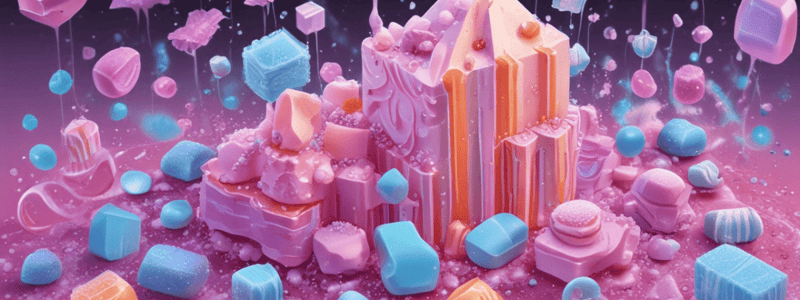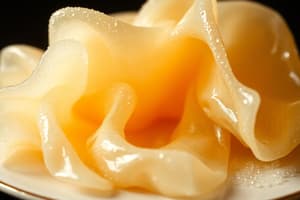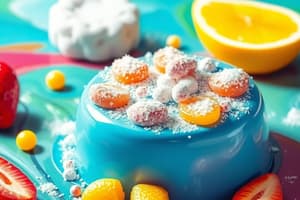Podcast
Questions and Answers
What happens when excessive washing down occurs in a sugar solution?
What happens when excessive washing down occurs in a sugar solution?
- The solution reaches the desired temperature faster
- The solution becomes more concentrated
- More water is introduced into the solution and the time required to achieve the desired temperature is lengthened (correct)
- The solution crystallizes
Why should sugar solutions not be stirred after they come to a boil?
Why should sugar solutions not be stirred after they come to a boil?
- Stirring promotes evaporation
- Stirring prevents the dissolution of sugar
- Stirring is not necessary after boiling
- Stirring promotes crystallization (correct)
What is the purpose of adding 'doctors' to sugar solutions?
What is the purpose of adding 'doctors' to sugar solutions?
- To add flavor to the solution
- To prevent crystallization (correct)
- To lower the boiling point of the solution
- To increase the solubility of sugar
Why are glucose and inverted sugar effective as 'doctors'?
Why are glucose and inverted sugar effective as 'doctors'?
When should 'doctors' be added to sugar solutions?
When should 'doctors' be added to sugar solutions?
How does a solution of tartaric acid help prevent sugar syrup crystallization?
How does a solution of tartaric acid help prevent sugar syrup crystallization?
What is the main purpose of crystallization in the production of sugar confections?
What is the main purpose of crystallization in the production of sugar confections?
What type of confections require controlled crystallization?
What type of confections require controlled crystallization?
Why is it important to avoid impurities in the production of sugar confections?
Why is it important to avoid impurities in the production of sugar confections?
What is the recommended initial heat when cooking saturated sugar solutions?
What is the recommended initial heat when cooking saturated sugar solutions?
What is the purpose of washing down the sides of the pot with a clean pastry brush and water?
What is the purpose of washing down the sides of the pot with a clean pastry brush and water?
What happens when the sugar solution is cooked with gas and the flames go up the sides of the pot?
What happens when the sugar solution is cooked with gas and the flames go up the sides of the pot?
Why is it important to use a sugar source that is known to be pure?
Why is it important to use a sugar source that is known to be pure?
What is the characteristic of noncrystalline confections?
What is the characteristic of noncrystalline confections?
What is the outcome of controlled crystallization in sugar confections?
What is the outcome of controlled crystallization in sugar confections?
What is the effect of crystallization on the texture of sugar confections?
What is the effect of crystallization on the texture of sugar confections?
Why is it crucial to prevent crystallization in the production of noncrystalline confections?
Why is it crucial to prevent crystallization in the production of noncrystalline confections?
How can uneven heat affect the cooking process of sugar solutions?
How can uneven heat affect the cooking process of sugar solutions?
What is the importance of ensuring that the sugar is completely dissolved before the sugar and water mixture comes to a boil?
What is the importance of ensuring that the sugar is completely dissolved before the sugar and water mixture comes to a boil?
What is the consequence of not using a sugar source that is known to be pure?
What is the consequence of not using a sugar source that is known to be pure?
Why is it crucial to monitor the temperature when cooking saturated sugar solutions?
Why is it crucial to monitor the temperature when cooking saturated sugar solutions?
What is the role of glucose and inverted sugars in sugar confections?
What is the role of glucose and inverted sugars in sugar confections?
What is the effect of introducing more water into a sugar solution during the cooking process?
What is the effect of introducing more water into a sugar solution during the cooking process?
What is the consequence of stirring a sugar solution after it has come to a boil?
What is the consequence of stirring a sugar solution after it has come to a boil?
What is the common characteristic of glucose and inverted sugar that makes them effective as 'doctors'?
What is the common characteristic of glucose and inverted sugar that makes them effective as 'doctors'?
What is the role of hydrolysis in a solution of tartaric acid?
What is the role of hydrolysis in a solution of tartaric acid?
Why is it important to add 'doctors' to the sugar solution after it has come to a boil?
Why is it important to add 'doctors' to the sugar solution after it has come to a boil?
What is the primary function of 'doctors' in sugar confectionery?
What is the primary function of 'doctors' in sugar confectionery?
What is the minimum cocoa content required by law in milk chocolate in the United States?
What is the minimum cocoa content required by law in milk chocolate in the United States?
What is the main difference between white chocolate and true chocolate?
What is the main difference between white chocolate and true chocolate?
What is the characteristic of origin chocolates?
What is the characteristic of origin chocolates?
What is the purpose of coating chocolate, also known as compound chocolate?
What is the purpose of coating chocolate, also known as compound chocolate?
What is special about gianduja, a type of specialty chocolate?
What is special about gianduja, a type of specialty chocolate?
What is the minimum percentage of cocoa butter required in white chocolate?
What is the minimum percentage of cocoa butter required in white chocolate?
What is the purpose of fractionalization of palm kernel oil in coating chocolate?
What is the purpose of fractionalization of palm kernel oil in coating chocolate?
What is the characteristic of specialty chocolates?
What is the characteristic of specialty chocolates?
What is the minimum cocoa content required in milk chocolate in the United States?
What is the minimum cocoa content required in milk chocolate in the United States?
What is the main difference between white chocolate and true chocolate?
What is the main difference between white chocolate and true chocolate?
What is the characteristic of origin chocolates?
What is the characteristic of origin chocolates?
What is the purpose of coating chocolate, also known as compound chocolate?
What is the purpose of coating chocolate, also known as compound chocolate?
What is special about gianduja, a type of specialty chocolate?
What is special about gianduja, a type of specialty chocolate?
What is the minimum percentage of cocoa butter required in white chocolate?
What is the minimum percentage of cocoa butter required in white chocolate?
Why is palm kernel oil fractionated in coating chocolate?
Why is palm kernel oil fractionated in coating chocolate?
What is the characteristic of specialty chocolates?
What is the characteristic of specialty chocolates?
What is the primary difference between European-style milk chocolate and American-style milk chocolate?
What is the primary difference between European-style milk chocolate and American-style milk chocolate?
What is the minimum percentage of cocoa butter required in white chocolate?
What is the minimum percentage of cocoa butter required in white chocolate?
What is the characteristic of origin chocolates?
What is the characteristic of origin chocolates?
What is the purpose of coating chocolate, also known as compound chocolate?
What is the purpose of coating chocolate, also known as compound chocolate?
What is special about gianduja, a type of specialty chocolate?
What is special about gianduja, a type of specialty chocolate?
What is the minimum percentage of cocoa mass required in milk chocolate in the United States?
What is the minimum percentage of cocoa mass required in milk chocolate in the United States?
What is the main difference between white chocolate and true chocolate?
What is the main difference between white chocolate and true chocolate?
What is the purpose of fractionalization of palm kernel oil in coating chocolate?
What is the purpose of fractionalization of palm kernel oil in coating chocolate?
Flashcards are hidden until you start studying
Study Notes
Crystallization in Sugar Confections
- Crystallization of sugar determines the subcategory of sugar confections it belongs to.
- Controlled crystallization is essential for crystalline confections like fondants and fudge, creating smooth and creamy characteristics.
- Crystallization must be avoided in noncrystalline confections like caramels, hard candies, and toffees, which have characteristics ranging from hard and brittle to soft and chewy.
Preventing Crystallization
- Avoid impurities by using clean tools, equipment, and ingredients to prevent contamination.
- Use a sugar source known to be pure to prevent contamination with flour or other impurities.
Temperature Control
- Begin cooking at a medium-high temperature to prevent premature crystallization.
- Increase temperature after the sugar solution has boiled, but avoid excessive heat.
- Ensure even heat distribution when cooking with gas to prevent premature browning.
Sugar Grains
- Ensure complete sugar dissolution before boiling to prevent undissolved sugar particles.
- Wash down the sides of the pot with a clean pastry brush and water to remove any undissolved sugar particles.
Agitation
- Avoid stirring sugar solutions after boiling to prevent crystallization.
- Stirring can promote crystallization, unless specified in the formula.
Adding Doctors
- Add additional ingredients like glucose, inverted sugar, or acids (like tartaric acid) to prevent crystallization.
- Add doctors after the solution has come to a boil, as they can inhibit the bonding of sucrose molecules.
- The molecular structures of glucose and inverted sugar can prevent crystallization by inhibiting sucrose molecule bonding.
- Tartaric acid can help prevent crystallization by partially inverting the solution through hydrolysis.
Crystallization in Sugar Confections
- Crystallization of sugar determines the subcategory of sugar confections it belongs to.
- Controlled crystallization is essential for crystalline confections like fondants and fudge, creating smooth and creamy characteristics.
- Crystallization must be avoided in noncrystalline confections like caramels, hard candies, and toffees, which have characteristics ranging from hard and brittle to soft and chewy.
Preventing Crystallization
- Avoid impurities by using clean tools, equipment, and ingredients to prevent contamination.
- Use a sugar source known to be pure to prevent contamination with flour or other impurities.
Temperature Control
- Begin cooking at a medium-high temperature to prevent premature crystallization.
- Increase temperature after the sugar solution has boiled, but avoid excessive heat.
- Ensure even heat distribution when cooking with gas to prevent premature browning.
Sugar Grains
- Ensure complete sugar dissolution before boiling to prevent undissolved sugar particles.
- Wash down the sides of the pot with a clean pastry brush and water to remove any undissolved sugar particles.
Agitation
- Avoid stirring sugar solutions after boiling to prevent crystallization.
- Stirring can promote crystallization, unless specified in the formula.
Adding Doctors
- Add additional ingredients like glucose, inverted sugar, or acids (like tartaric acid) to prevent crystallization.
- Add doctors after the solution has come to a boil, as they can inhibit the bonding of sucrose molecules.
- The molecular structures of glucose and inverted sugar can prevent crystallization by inhibiting sucrose molecule bonding.
- Tartaric acid can help prevent crystallization by partially inverting the solution through hydrolysis.
Milk Chocolate
- Made from chocolate liquor, sugar, milk solids, vanilla, and lecithin
- Cocoa content can range from 10 to 45 percent
- European-style milk chocolate is darker and may have a caramel taste due to high-temperature conching
- In the United States, milk chocolate must contain at least 10 percent cocoa mass and 12 percent milk solids by law
White Chocolate
- Not a true chocolate because it contains no cocoa solids
- Made from cocoa butter, milk solids, sugar, and flavoring ingredients
- Must contain at least 20 percent cocoa butter and 14 percent milk solids by FDA standards (revised in 2002)
Specialty Chocolates
- Includes products like gianduja (milk chocolate combined with nut paste, usually hazelnut) and flavored chocolates (e.g., cappuccino, coffee, or orange)
- This category is emerging as consumers become more aware of quality cocoa and more adventurous in taste
- Some confectioners produce chocolate bars with additions like spices, dried fruits, and nuts, which are not regulated
Origin Chocolates
- Made using beans from one growing region, resulting in uniquely flavored chocolate
- Flavor highlights local cocoa varieties and production nuances, similar to estate wines
- Prized for their unique and unadulterated flavor
Coating and Compound Chocolate
- Made with cocoa butter equivalents (CBEs), designed for use without tempering
- Can use palm kernel oil, a common CBE, which is fractionated to mirror cocoa butter's crystallization properties
- Eliminates the need to temper the coating or compound chocolate after it has melted
- Has a less appealing taste and mouthfeel compared to couverture due to higher melting point
- Often used in conjunction with couverture for chocolate glazes, with a working temperature of 95°F (35°C)
Milk Chocolate
- Made from chocolate liquor, sugar, milk solids, vanilla, and lecithin
- Cocoa content can range from 10 to 45 percent
- European-style milk chocolate is darker and may have a caramel taste due to high-temperature conching
- In the United States, milk chocolate must contain at least 10 percent cocoa mass and 12 percent milk solids by law
White Chocolate
- Not a true chocolate because it contains no cocoa solids
- Made from cocoa butter, milk solids, sugar, and flavoring ingredients
- Must contain at least 20 percent cocoa butter and 14 percent milk solids by FDA standards (revised in 2002)
Specialty Chocolates
- Includes products like gianduja (milk chocolate combined with nut paste, usually hazelnut) and flavored chocolates (e.g., cappuccino, coffee, or orange)
- This category is emerging as consumers become more aware of quality cocoa and more adventurous in taste
- Some confectioners produce chocolate bars with additions like spices, dried fruits, and nuts, which are not regulated
Origin Chocolates
- Made using beans from one growing region, resulting in uniquely flavored chocolate
- Flavor highlights local cocoa varieties and production nuances, similar to estate wines
- Prized for their unique and unadulterated flavor
Coating and Compound Chocolate
- Made with cocoa butter equivalents (CBEs), designed for use without tempering
- Can use palm kernel oil, a common CBE, which is fractionated to mirror cocoa butter's crystallization properties
- Eliminates the need to temper the coating or compound chocolate after it has melted
- Has a less appealing taste and mouthfeel compared to couverture due to higher melting point
- Often used in conjunction with couverture for chocolate glazes, with a working temperature of 95°F (35°C)
Milk Chocolate
- Made from chocolate liquor, sugar, milk solids, vanilla, and lecithin
- Cocoa content can range from 10 to 45 percent
- European-style milk chocolate is darker and may have a caramel taste due to high-temperature conching
- In the United States, milk chocolate must contain at least 10 percent cocoa mass and 12 percent milk solids by law
White Chocolate
- Not a true chocolate because it contains no cocoa solids
- Made from cocoa butter, milk solids, sugar, and flavoring ingredients
- Must contain at least 20 percent cocoa butter and 14 percent milk solids by FDA standards (revised in 2002)
Specialty Chocolates
- Includes products like gianduja (milk chocolate combined with nut paste, usually hazelnut) and flavored chocolates (e.g., cappuccino, coffee, or orange)
- This category is emerging as consumers become more aware of quality cocoa and more adventurous in taste
- Some confectioners produce chocolate bars with additions like spices, dried fruits, and nuts, which are not regulated
Origin Chocolates
- Made using beans from one growing region, resulting in uniquely flavored chocolate
- Flavor highlights local cocoa varieties and production nuances, similar to estate wines
- Prized for their unique and unadulterated flavor
Coating and Compound Chocolate
- Made with cocoa butter equivalents (CBEs), designed for use without tempering
- Can use palm kernel oil, a common CBE, which is fractionated to mirror cocoa butter's crystallization properties
- Eliminates the need to temper the coating or compound chocolate after it has melted
- Has a less appealing taste and mouthfeel compared to couverture due to higher melting point
- Often used in conjunction with couverture for chocolate glazes, with a working temperature of 95°F (35°C)
Studying That Suits You
Use AI to generate personalized quizzes and flashcards to suit your learning preferences.




